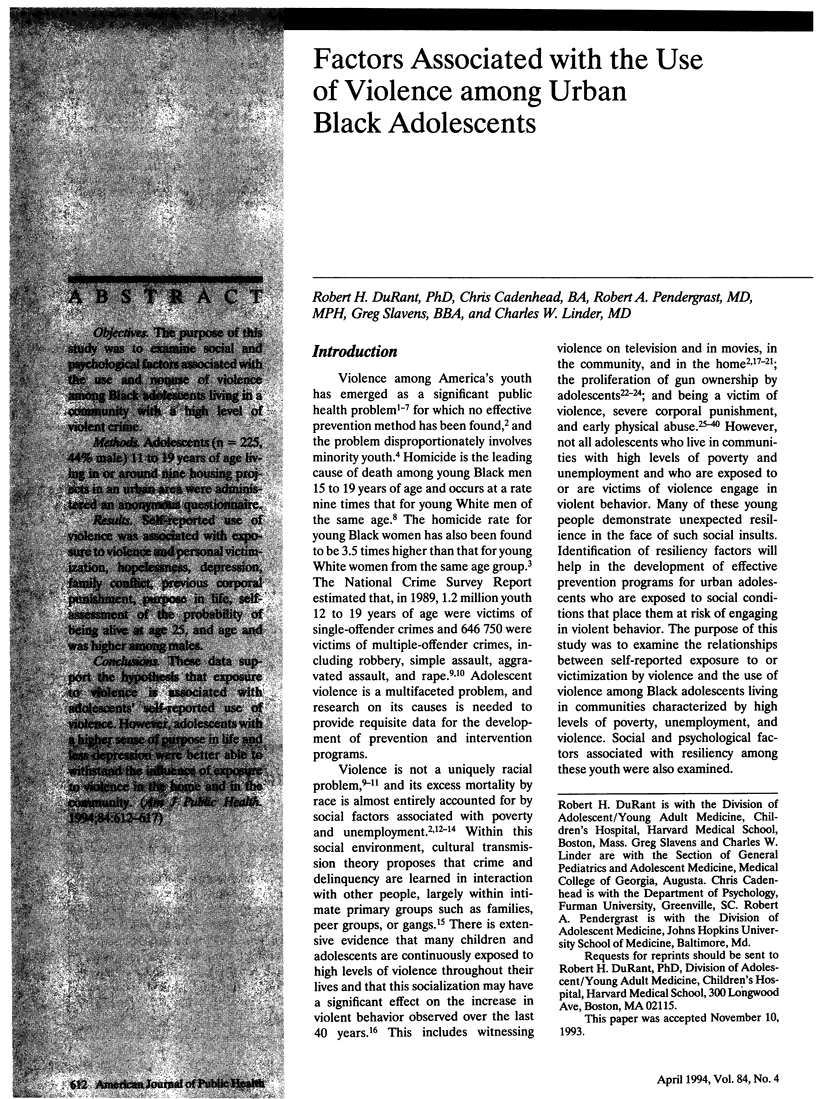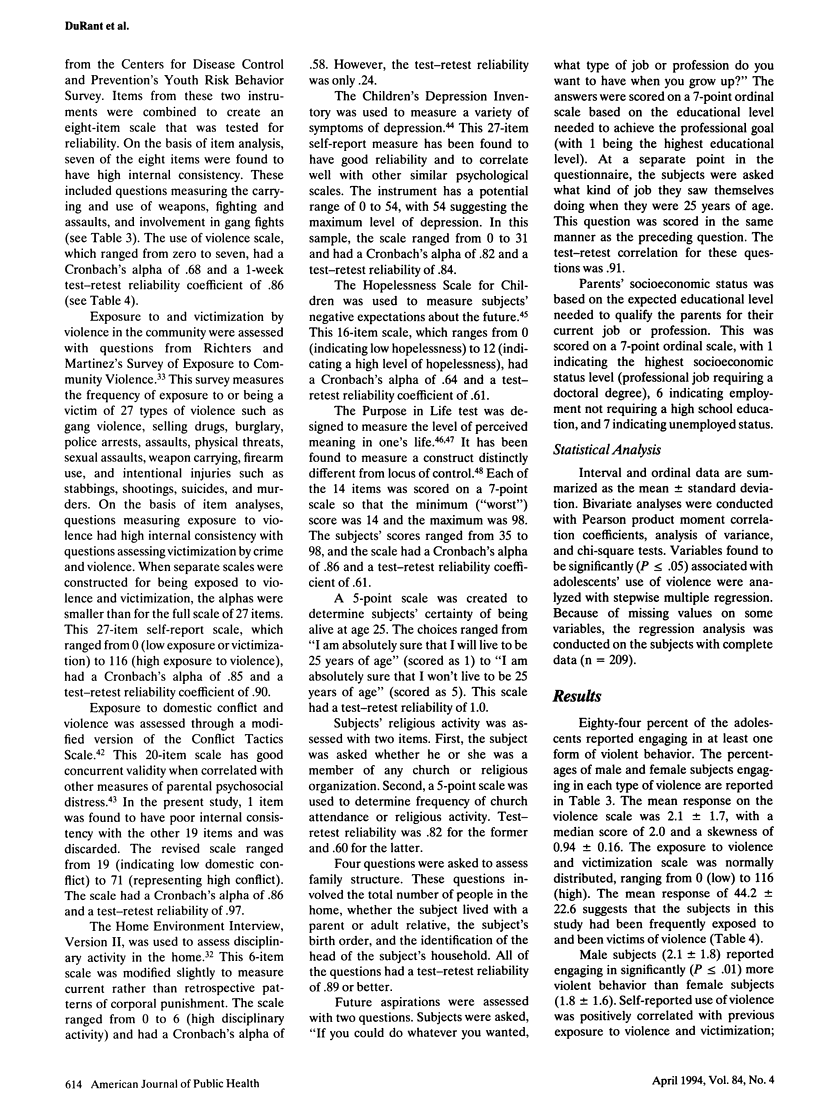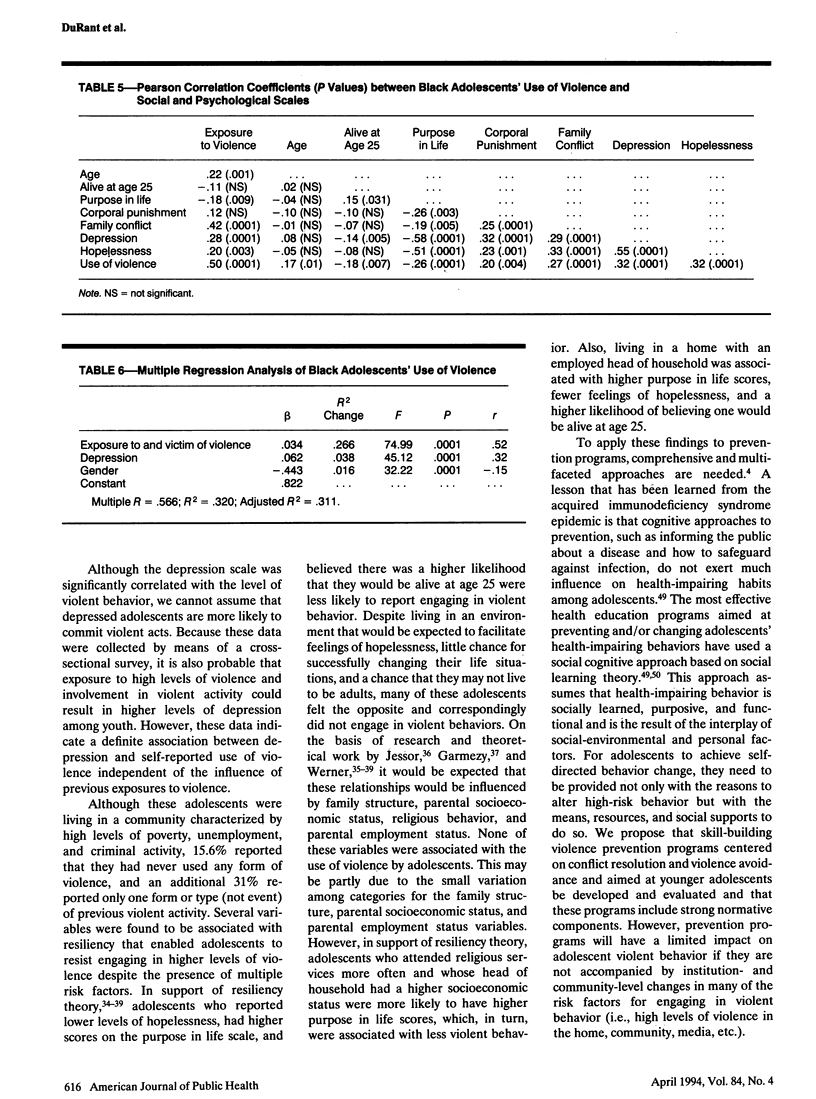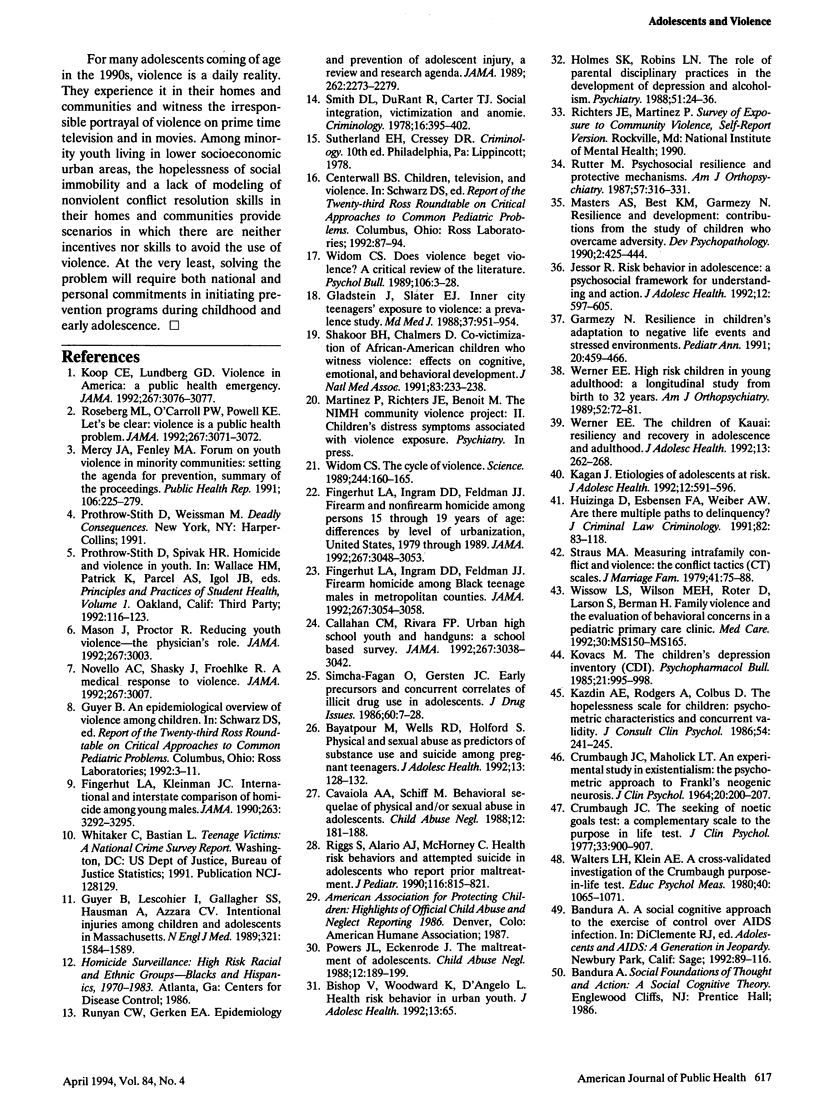Abstract
OBJECTIVES. The purpose of this study was to examine social and psychological factors associated with the use and nonuse of violence among Black adolescents living in a community with a high level of violent crime. METHODS. Adolescents (n = 225, 44% male) 11 to 19 years of age living in or around nine housing projects in an urban area were administered an anonymous questionnaire. RESULTS. Self-reported use of violence was associated with exposure to violence and personal victimization, hopelessness, depression, family conflict, previous corporal punishment, purpose in life, self-assessment of the probability of being alive at age 25, and age and was higher among males. CONCLUSIONS. These data support the hypothesis that exposure to violence is associated with adolescents' self-reported use of violence. However, adolescents with a higher sense of purpose in life and less depression were better able to withstand the influence of exposure to violence in the home and in the community.
Full text
PDF





Selected References
These references are in PubMed. This may not be the complete list of references from this article.
- Bayatpour M., Wells R. D., Holford S. Physical and sexual abuse as predictors of substance use and suicide among pregnant teenagers. J Adolesc Health. 1992 Mar;13(2):128–132. doi: 10.1016/1054-139x(92)90079-q. [DOI] [PubMed] [Google Scholar]
- CRUMBAUGH J. C., MAHOLICK L. T. AN EXPERIMENTAL STUDY IN EXISTENTIALISM: THE PSYCHOMETRIC APPROACH TO FRANKL'S CONCEPT OF NOOGENIC NEUROSIS. J Clin Psychol. 1964 Apr;20:200–207. doi: 10.1002/1097-4679(196404)20:2<200::aid-jclp2270200203>3.0.co;2-u. [DOI] [PubMed] [Google Scholar]
- Callahan C. M., Rivara F. P. Urban high school youth and handguns. A school-based survey. JAMA. 1992 Jun 10;267(22):3038–3042. [PubMed] [Google Scholar]
- Cavaiola A. A., Schiff M. Behavioral sequelae of physical and/or sexual abuse in adolescents. Child Abuse Negl. 1988;12(2):181–188. doi: 10.1016/0145-2134(88)90026-9. [DOI] [PubMed] [Google Scholar]
- Crumbaugh J. C. The Seeking of Noetic Goals Test (SONG): a complementary scale to the Purpose in Life Test (PIL). J Clin Psychol. 1977 Jul;33(3):900–907. doi: 10.1002/1097-4679(197707)33:3<900::aid-jclp2270330362>3.0.co;2-8. [DOI] [PubMed] [Google Scholar]
- Fingerhut L. A., Ingram D. D., Feldman J. J. Firearm and nonfirearm homicide among persons 15 through 19 years of age. Differences by level of urbanization, United States, 1979 through 1989. JAMA. 1992 Jun 10;267(22):3048–3053. [PubMed] [Google Scholar]
- Fingerhut L. A., Ingram D. D., Feldman J. J. Firearm homicide among black teenage males in metropolitan counties. Comparison of death rates in two periods, 1983 through 1985 and 1987 through 1989. JAMA. 1992 Jun 10;267(22):3054–3058. [PubMed] [Google Scholar]
- Fingerhut L. A., Kleinman J. C. International and interstate comparisons of homicide among young males. JAMA. 1990 Jun 27;263(24):3292–3295. [PubMed] [Google Scholar]
- Forum on youth violence in minority communities: setting the agenda for prevention. December 10-12, 1990, Atlanta, Georgia. Proceedings. Public Health Rep. 1991 May-Jun;106(3):225–279. [PMC free article] [PubMed] [Google Scholar]
- Garmezy N. Resilience in children's adaptation to negative life events and stressed environments. Pediatr Ann. 1991 Sep;20(9):459-60, 463-6. doi: 10.3928/0090-4481-19910901-05. [DOI] [PubMed] [Google Scholar]
- Gladstein J., Slater E. J. Inner city teenagers' exposure to violence: a prevalence study. Md Med J. 1988 Dec;37(12):951–954. [PubMed] [Google Scholar]
- Guyer B., Lescohier I., Gallagher S. S., Hausman A., Azzara C. V. Intentional injuries among children and adolescents in Massachusetts. N Engl J Med. 1989 Dec 7;321(23):1584–1589. doi: 10.1056/NEJM198912073212306. [DOI] [PubMed] [Google Scholar]
- Holmes S. J., Robins L. N. The role of parental disciplinary practices in the development of depression and alcoholism. Psychiatry. 1988 Feb;51(1):24–36. doi: 10.1080/00332747.1988.11024377. [DOI] [PubMed] [Google Scholar]
- Jessor R. Risk behavior in adolescence: a psychosocial framework for understanding and action. J Adolesc Health. 1991 Dec;12(8):597–605. doi: 10.1016/1054-139x(91)90007-k. [DOI] [PubMed] [Google Scholar]
- Kagan J. Etiologies of adolescents at risk. J Adolesc Health. 1991 Dec;12(8):591–596. doi: 10.1016/1054-139x(91)90006-j. [DOI] [PubMed] [Google Scholar]
- Kazdin A. E., Rodgers A., Colbus D. The hopelessness scale for children: psychometric characteristics and concurrent validity. J Consult Clin Psychol. 1986 Apr;54(2):241–245. doi: 10.1037//0022-006x.54.2.241. [DOI] [PubMed] [Google Scholar]
- Koop C. E., Lundberg G. B. Violence in America: a public health emergency. Time to bite the bullet back. JAMA. 1992 Jun 10;267(22):3075–3076. [PubMed] [Google Scholar]
- Kovacs M. The Children's Depression, Inventory (CDI). Psychopharmacol Bull. 1985;21(4):995–998. [PubMed] [Google Scholar]
- Mason J., Proctor R. From the Assistant Secretary for Health, US Public Health Service. JAMA. 1992 Jun 10;267(22):3003–3003. doi: 10.1001/jama.267.22.3003. [DOI] [PubMed] [Google Scholar]
- Powers J. L., Eckenrode J. The maltreatment of adolescents. Child Abuse Negl. 1988;12(2):189–199. doi: 10.1016/0145-2134(88)90027-0. [DOI] [PubMed] [Google Scholar]
- Riggs S., Alario A. J., McHorney C. Health risk behaviors and attempted suicide in adolescents who report prior maltreatment. J Pediatr. 1990 May;116(5):815–821. doi: 10.1016/s0022-3476(05)82679-4. [DOI] [PubMed] [Google Scholar]
- Rosenberg M. L., O'Carroll P. W., Powell K. E. Let's be clear. Violence is a public health problem. JAMA. 1992 Jun 10;267(22):3071–3072. doi: 10.1001/jama.267.22.3071. [DOI] [PubMed] [Google Scholar]
- Runyan C. W., Gerken E. A. Epidemiology and prevention of adolescent injury. A review and research agenda. JAMA. 1989 Oct 27;262(16):2273–2279. [PubMed] [Google Scholar]
- Rutter M. Psychosocial resilience and protective mechanisms. Am J Orthopsychiatry. 1987 Jul;57(3):316–331. doi: 10.1111/j.1939-0025.1987.tb03541.x. [DOI] [PubMed] [Google Scholar]
- Shakoor B. H., Chalmers D. Co-victimization of African-American children who witness violence: effects on cognitive, emotional, and behavioral development. J Natl Med Assoc. 1991 Mar;83(3):233–238. [PMC free article] [PubMed] [Google Scholar]
- Werner E. E. High-risk children in young adulthood: a longitudinal study from birth to 32 years. Am J Orthopsychiatry. 1989 Jan;59(1):72–81. [PubMed] [Google Scholar]
- Werner E. E. The children of Kauai: resiliency and recovery in adolescence and adulthood. J Adolesc Health. 1992 Jun;13(4):262–268. doi: 10.1016/1054-139x(92)90157-7. [DOI] [PubMed] [Google Scholar]
- Widom C. S. Does violence beget violence? A critical examination of the literature. Psychol Bull. 1989 Jul;106(1):3–28. doi: 10.1037/0033-2909.106.1.3. [DOI] [PubMed] [Google Scholar]
- Widom C. S. The cycle of violence. Science. 1989 Apr 14;244(4901):160–166. doi: 10.1126/science.2704995. [DOI] [PubMed] [Google Scholar]
- Wissow L. S., Wilson M. E., Roter D., Larson S., Berman H. I. Family violence and the evaluation of behavioral concerns in a pediatric primary care clinic. Med Care. 1992 May;30(5 Suppl):MS150–MS165. doi: 10.1097/00005650-199205001-00013. [DOI] [PubMed] [Google Scholar]


